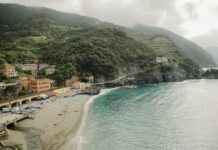Since the announcement in 1991 of the discovery of this cave, adorned with more than 30,000 years in the depths of the creeks of Marseille, the idea of making a replica for a large public has quickly germinated.
But it took until 2016 for the Provence-Alpes-Côte-d’Azur Region to decide to set it up at the Villa Méditerranée, a modern but unused building, ideally located next to the Mucem, the Museum of European Civilizations. and the Mediterranean, in the heart of France’s second city.
On Saturday, after two and a half years of work, the Kléber-Rossillon company, chosen to lead and manage this 23 million euro project, will open to the general public the third copy of a prehistoric cave in France after those of Lascaux in the Dordogne. and Chauvet in Ardèche that she had already made.
It was in 1985 that Henri Cosquer, 72, scuba diver and organizer of a diving school in the Mediterranean, said that he had fallen by chance, at a depth of 37 meters, on the entrance to the cave which today bears today his name.
On its emerged walls, an unforgettable spectacle awaited him: the representation of 229 figures of 13 animal species, horses, ibexes, cattle, deer, bison, saiga antelopes but also seals, penguins, fish, never seen in other prehistoric caves. already discovered.
«Our desire was to show a wide audience this inaccessible place but also to preserve a heritage doomed to disappear by the rise of the sea», explained the promoters of the «Cosquer Méditerranée» project.
– «if Cro-Magnon could come back» –
«The result is fabulous. We can see the drawings better than in the real cave» enthused Henri Cosquer on Thursday after a press visit. «If the Cro-Magnon man could come back he would say: you men, you now manage to move the rocks and put them in the right direction so that we can see our paintings well», he laughed.
If Thursday everything was not yet stalled – a footbridge not delivered, workers mobilized for final work, a computer program to be settled – the boss Geneviève Rossillon wanted to be confident for D-Day, saying to herself both «impatient and stressed «.
In the basin surrounding the building, the replica of Henri Coquer’s boat, the «Cro-Magnon», has arrived safely.
At the entrance to the site, after passing in front of the reconstruction of a diving club and that of the «Le France» café, the headquarters of the Cassis divers, an audio-guide in six languages is given to visitors.
An elevator transformed into a diving cabin with marine images in portholes, descends to the basement, below sea level, where the curious embark by six in an exploration vehicle for a visit of 35 mn and 220 meters of route through the reconstituted cave.
Rocked by the voice of actor Philippe Caubère, on a story by prehistorian Thierry Felix, visitors glide silently through a reconstituted mineral garden with its stalactites, its wet effects, its transparencies, its patina and its water basins reflecting the rock.
The main panels of the cave, copied by visual artists, follow one another under beams of light: «The beach» (entrance door to discovery), «the panel of the horses», «the marine animals», «the large well» with his black hands and «the sign of the bison» and his red hands.
«If we don’t see all the drawings, it doesn’t matter, what matters is the experience», judge Gilles Tosselo, visual artist, evoking the serenity of the place, far from the noises of the city yet so close.
If the original of the Cosquer cave is larger than its replica, «1,750 m2 of cavern, 100% of the painted walls and 90% of the engraved walls will be shown», assures Laurent Delbos, site manager.
The visit ends on the top floor of the building with exhibitions dedicated to prehistory and global warming, including a dynamic projection illustrating the rising waters in the bay of Marseille. Some 800,000 visitors are expected the first year, 500,000 the following.















